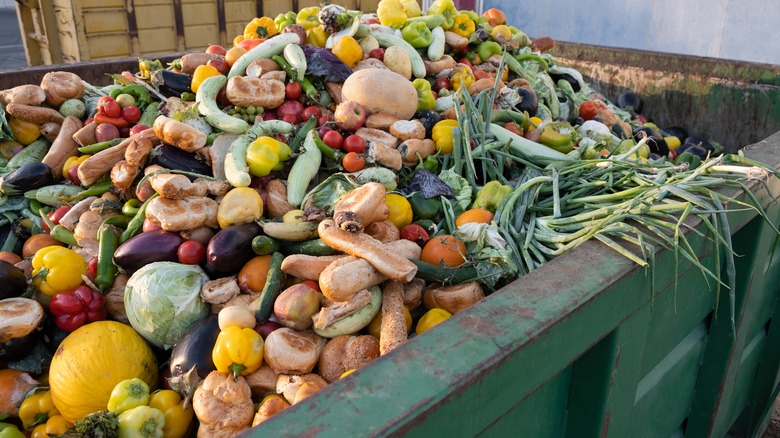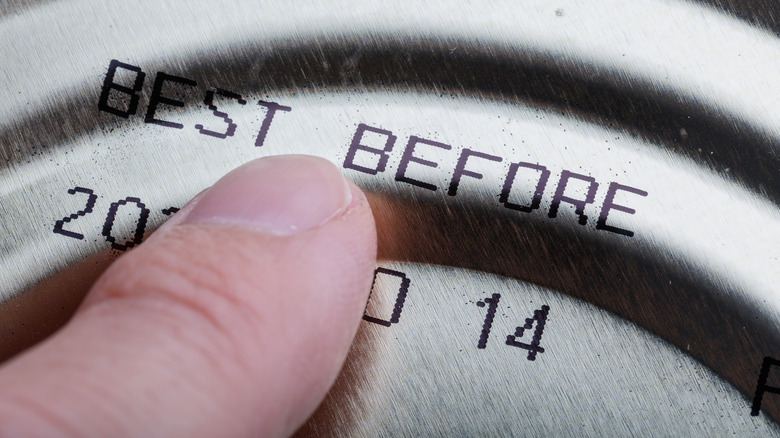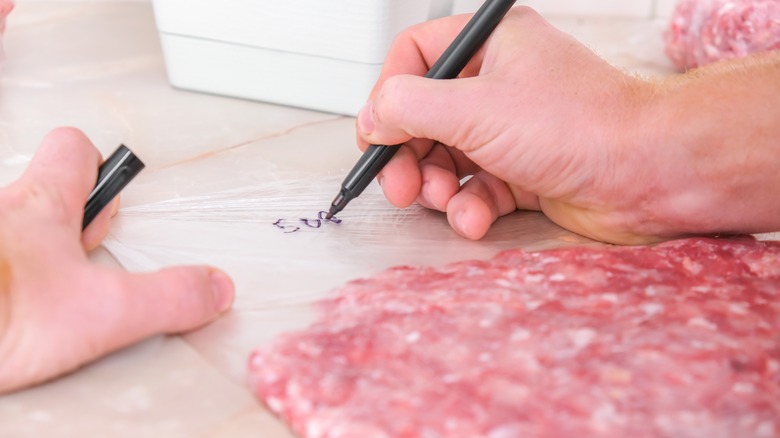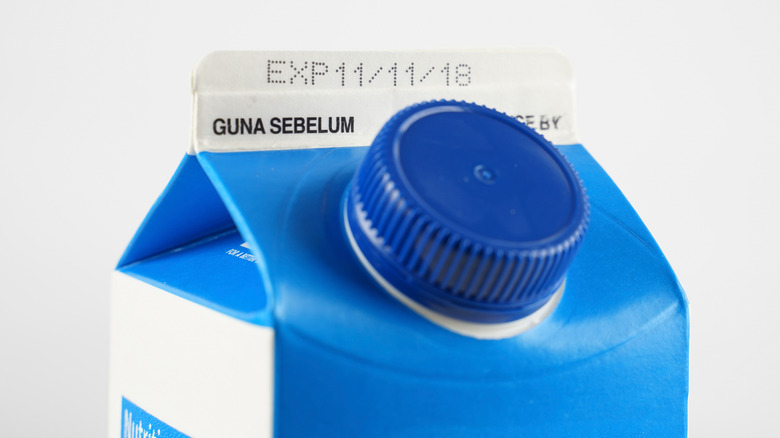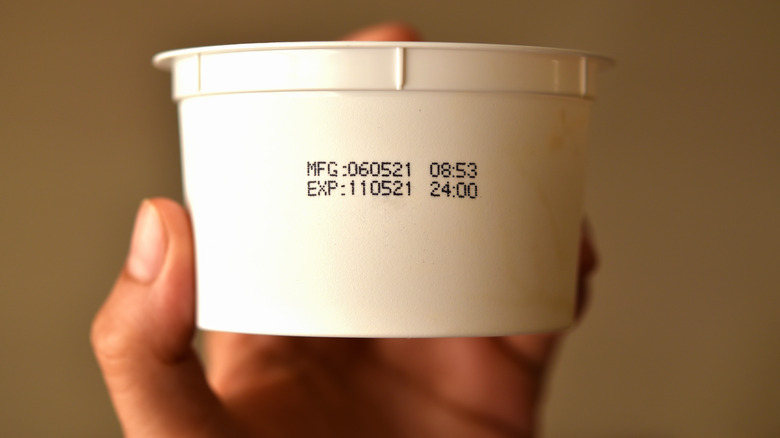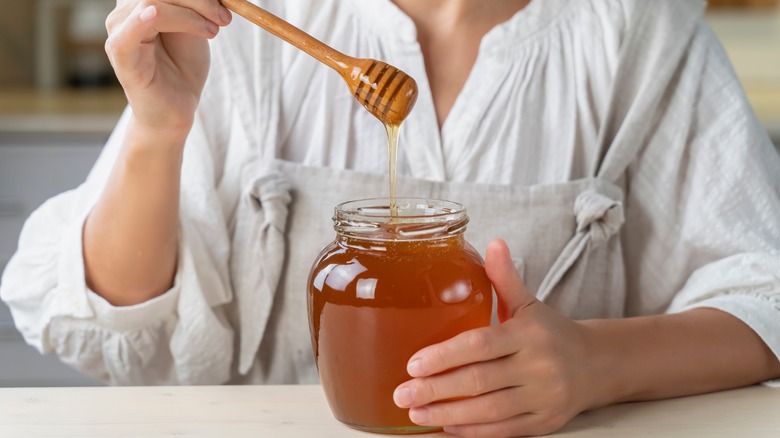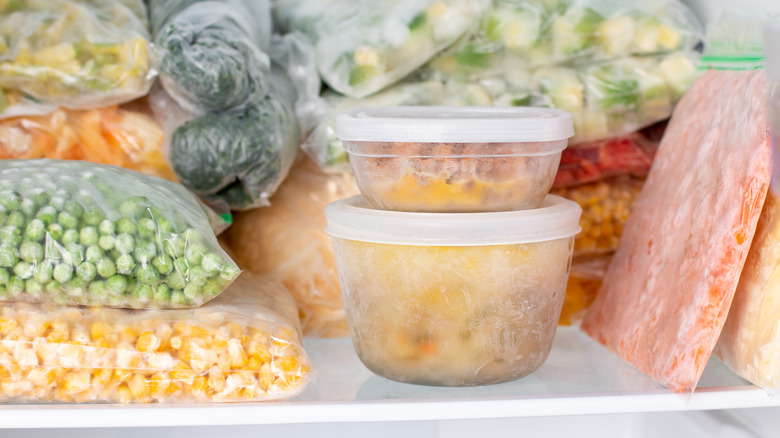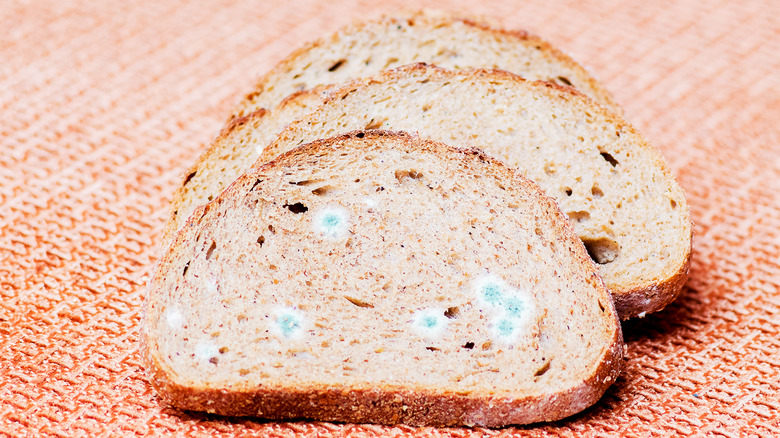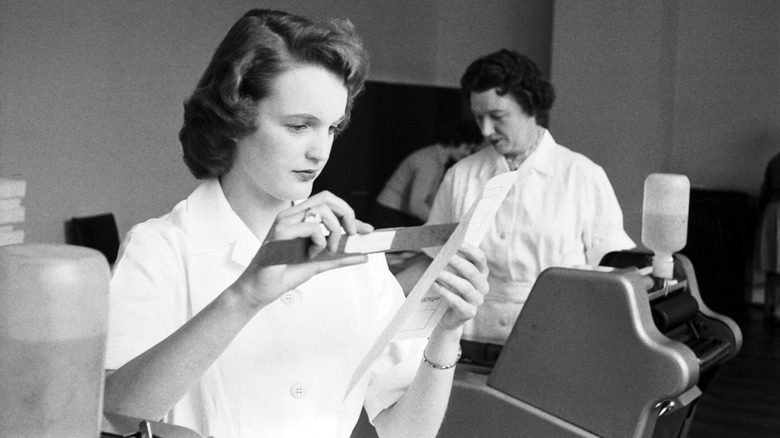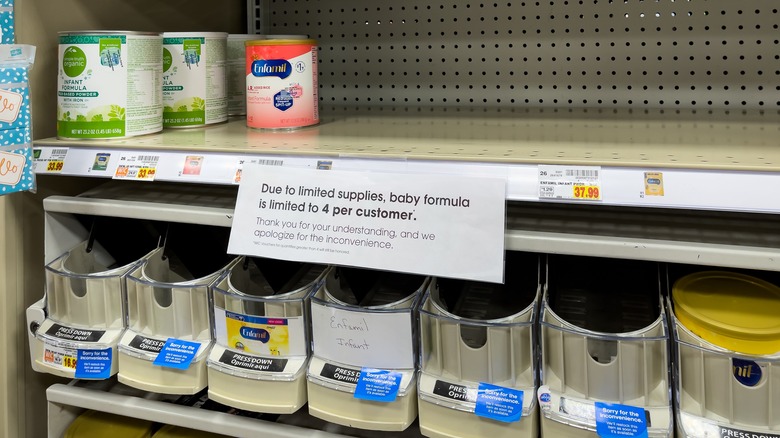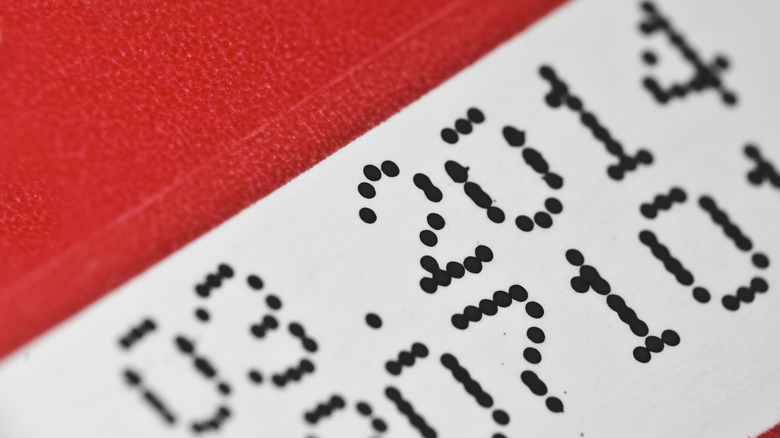Myths About Expiration Dates You Should Stop Believing
We may receive a commission on purchases made from links.
Expiration dates on food packaging are a source of comfort and exasperation for consumers, manufacturers, and waste-reduction activists alike. The dates, which usually include a phrase such as "best by," are often interpreted as being absolute when they're not. While the dates can be helpful to point out when food might start going bad, they aren't always accurate, mean different things, and have led to massive food waste. ReFED estimates that 54 million tons of food are thrown out annually as consumers discard anything past the label date.
Before we go on, let's emphasize that most food does expire, becoming unsafe to eat. With the exception of consistently frozen products, food can go bad in terms of safety and quality. "When in doubt, throw it out" isn't an empty phrase. However, the controversies surrounding expiration dates stem from a chronic misinterpretation of terms. The dating system as it stands is helpful as not everyone has a sense of smell or taste they can trust (via University of Utah Health). But much of what consumers think they know about expiration dates is based on misinformation. Here are myths about expiration dates you should stop believing.
You need to stop using products on the date listed
Expiration dates don't necessarily indicate the exact day you need to discard a product. Terms like "best by" are not strict limits, but rather the day after which manufacturers won't guarantee the quality of a product. CNN says that as far back as 1979, studies found that expiration dates did not truly indicate freshness. Indeed, many foods are still good past their expiration date.
In 2019, Maryland station WTOP News reported on a man who spent a year eating food well beyond the dates on the packaging, including year-old tortillas, six-month-old yogurt, and meat 15 days past its expiration date. He clearly took risks, especially with the meat, and we certainly don't recommend going to the same lengths he did. However, he was careful and inspected the food, ensuring it smelled and looked fine, and ultimately did not get sick.
But even terms that seem absolute, such as "do not use after," are sometimes more of a quality issue than a safety one. WebMD uses cake mix as an example; after the listed date, the yeast in the product may not work well even if it has not actually spoiled. Keep in mind that if the product smells or looks off, or if you see evidence of mold, toss it no matter the date indicated.
They mean absolutely nothing
Despite the problems that dates can cause with regard to food waste, it's a myth that they are entirely meaningless. First, infant formula is federally required to have an expiration date because it must contain specific amounts of nutrients. Past the date, the nutrients may start to become inactive. Meanwhile, labels on packages of raw meat advising to use or freeze it by a certain date indicate when safety is likely to become a problem.
Even vague dates like "best if used by" have their value. It's still nice to know when something may no longer taste as good as it should, and it's a bit worrying to bite into food when you have no idea how old it could be. Retailers use these dates to figure out when to pull products from shelves (although, worryingly, the University of Connecticut says they aren't legally required to remove outdated goods except for baby formula). The current dating system isn't perfect by any means, but it's better than nothing.
Terms are standardized across the food industry
The terms used by manufacturers can mean different things to different companies, and Vox reports that even the same type of food may have a sell-by date from one company and a best-before date from another. It's a myth that these terms are all based on the same standards.
However, determining that date is surprisingly subjective. According to Gizmodo, manufacturers will put food through extensive tests to see when a product starts to lose flavor and spoil, but there's no single laboratory that tests all products. The resulting dates and time ranges are unique to the specific brand and product being tested.
State regulations also play a role, and different limits, minimums, and meanings for terms exist. Ultimately, the final result can change drastically across state lines. To illustrate, NPR examined various expiration dates in July 2022 and reported that whereas pasteurized milk has to be sold within 12 days of pasteurization in Montana, it can be sold up to 20 days after in Idaho.
Food with a use-by date expires right at midnight
It's worth noting that food products with specific dates after which they shouldn't be consumed don't suddenly go bad at midnight (via Time). There's no workforce of bacteria waiting to clock in, ready to infect the food. In fact, it may have already been going bad. So, if it's 12:01 a.m. on the day after the expiration date, you can't assume the food is either safe or unsafe. Always inspect an item to see if the food is spoiled before eating or freezing it. As for meat products like raw chicken or beef, it's better to throw them out just in case.
Here's where it gets interesting. The U.K. Food Standards Agency advises not using or eating food with a use-by date past midnight of the day it supposedly expires. Manufacturers don't make foods with specific expiration times for different time zones; you don't have products that expire at midnight in New York while remaining good for three more hours in California. So why the discrepancy? The Food Standards Agency doesn't address this, but midnight is a very easy time to remember, making it useful for people who prefer not to take a chance or who lack a sense of smell or taste.
Everything needs an expiration date
Some foods don't really expire at all. It's rare but true, and honey is the best example. Honey has very little moisture and is on the acidic side of the pH scale, meaning the conditions are not great for bacterial growth (via Healthline). Without the usual driver behind decay present, honey is safe to eat for a very long time. That being said, we're probably so used to seeing an expiration date that finding food without any code, be it an expiration date or a Julian-calendar production date, would be alarming. Honey may never go bad, but it's nice to have some indication of just how long it's been sitting around.
Honey can still spoil even if it doesn't technically expire, according to Eating Well. If it isn't stored correctly, moisture can get past the seal, causing the honey to develop mold (via Smithsonian magazine). In this instance or if the honey smells odd, throw it out. This is not a case where you can scoop out the mold and keep eating.
Bottled water actually expires
If you've poured bottled water down the drain because it was past the expiration date on the label, you were partly prey to myth. While bottled water is labeled with an expiration date, usually two years after the time it was produced, the water is still fine. Mental Floss explains that the date is indicated because New Jersey briefly required expiration dates of two years or less on all consumables. Bottling plants simply added it to all the bottles they produced to simplify the manufacturing process. It would have been possible but highly annoying to only print dates on some bottles and keep track of what was shipped where. After the regulation was removed, manufacturers just kept placing dates on water bottles.
Live Science also points out that there's a legal reason for the date, though it's unrelated to any manufacturing standard. Instead, the label is meant to protect the company. If someone complains about the water, bottlers can point to the older date and avoid blame for any issues regarding quality.
While water itself doesn't expire, the plastic bottle it's stored in can start to decline in quality over time. Healthline warns that you may not want to drink bottled water that's over two years old anyway, as chemicals like bisphenol A can leach into the liquid.
Frozen foods expire
If you want to debate about the best kitchen invention in history other than the refrigerator, the freezer would be a pretty good candidate. When you freeze foods, they temporarily stop decaying and stay in that state as long as they remain frozen. The only real risk the food faces — other than a power outage that causes it to thaw into the danger zone — is freezer burn. Healthline explains that this occurs when frozen food dries out, deteriorating its quality. The food is still safe to eat, but it may have a less-than-pleasant flavor or texture.
Why do foods have to be kept below 0 F if freezing temperatures start at 32 F? The answer is both one of research and convenience. According to appliance manufacturer Liebherr, when freezers were first in use, 14 F was considered a good temperature for keeping food completely frozen. However, in the 1930s, the American Fruit and Vegetable Coalition started advocating 0 F as the proper freezer temperature, simply because it was easy to remember.
This proved to be a good move, though; it turns out that above 0 F, nutrients decay faster than they would at temperatures below 0 F. Freezing food at colder temperatures consumes too much extra energy, so 0 F is seen as a good-enough temperature that's balanced between preserving nutrients and your utility bill.
You have to throw out anything showing the slightest decay
Expiration dates make it sound like once a food passes this pivotal moment, you absolutely have to throw it out. Combine a best-by date with greens that look a bit wilted, for example, and it might seem to be the case. But even this isn't so simple. Some deterioration is actually not a problem as long as you don't eat the decayed portion.
A great example is mold on hard cheese. According to the Mayo Clinic, as long as you cut away the mold and the surrounding inch, and provided that the rest of the cheese doesn't smell bad or look suspect, it should be edible. This is not the case for all moldy foods; Bustle reports that items like bread need to be thrown out even if they only have a little bit of mold. Overripe or soft fruit that doesn't have mold can be used for quickbreads and other cooked desserts or jam.
But again, be careful. You have to learn what "normal and safe to eat" smells, tastes, and looks like. Inverse reports that it's not just the taste and smell but also the consistency, texture, and even color that provide clues as to how safe a food product is to eat. You'll become more experienced over time but always err on the side of caution. It's better to throw out food you're not sure about than it is to eat something that could make you sick.
Expiration dates are required
A big myth is that expiration dates are required at all. Really, they're not federally mandated except for dates on baby formula, according to the Food Safety and Inspection Service. In fact, the idea of dating food products isn't that old and only exists thanks to the public perception that food might be unsafe. Expiration dates were first used in the 1950s at U.K. retailer Marks & Spencer for foods in its storerooms (via The Guardian).
It wasn't until about 1970 that the dates showed up on store shelves and they weren't yet what we use today; "sell by" wasn't a thing until 1973. Customers became more concerned about the safety of their food, and stores and manufacturers started adding dates to more products throughout the 1970s. According to a report by the National Resources Defence Council and Harvard University, many states went ahead and created their own regulations regarding food expiration dating. Depending on where you live, the dates might actually be required by your state government.
If you've heard rumors that expiration dates exist thanks to gangster Al Capone, it turns out that story is unverified. The details vary, with the main characters being anyone from Capone and his daughter to Capone's brother and the son of a man he knew. HuffPost tried to find evidence that the Capone story was true, however, other than his granddaughter's insistence that it was factual, the outlet couldn't find any proof.
Dates on baby formula mean the same as other expiration dates
Baby formula is a special case. It's not only the sole federally mandated expiration date, but it means something different than a date for, say, raw meat. The product has to contain a carefully crafted formula of nutrients. As such, the use-by date indicates the point at which these nutrients start to deteriorate.
Past this date, the formula is no longer guaranteed to have the required amounts of each nutrient. The formula's quality may also change, making it harder for the fluid to pass through the tip of a bottle. The expiration date is so important that even during the formula shortage during the pandemic, the U.S. Department of Health & Human Services still advised against using expired formula.
Despite these measures, formula dates aren't necessarily a marker of food safety. In 2013, NBC Connecticut investigated reports of expired baby formula on sale in stores and found multiple bottles that should have been pulled months before. Nicole Newman, a licensed dietitian, told the station that the expired formula might not necessarily create immediate health problems, although the risk of long-term health issues was a known problem. Still, feeding expired formula to a baby whose immune system isn't yet developed sounds like a bad idea.
Each expiration date has a month and day listed
This may sound like a minor myth that shouldn't be of concern, but failing to realize that product dates don't always have both a month and a day can create confusion. First, if a poultry, egg, or meat producer is regulated by the Food Safety and Inspection Service, then the dates they use on labels have to follow a specific format. That includes an explanatory phrase like "use by" plus a minimum of the month and day. The year is required if the product is supposed to be frozen or left on the shelf (in other words, if it's meant to last for a long time).
Past these requirements and those for infant formula, there is no single date format that companies have to use. It's common to find only the month and year, for example. That can lead to surprises for consumers, as one Redditor found out. They asked the /r/CrappyDesign community about a date they found marked "JU 5.2022" and wanted to know if the JU meant June or July. The answer? May. Responses were almost unanimous that "JU" was a manufacturer code, and the number 5 meant the month of May and not the fifth day of the month.
No one's doing anything about them
If the variety of terms and lack of concrete advice have you ready to eat only frozen foods for the rest of your life, we hear you. So do a lot of other people who work behind the scenes to address the problem with these dates. The solutions they've come up with have been a mix of federal legislation, creating new systems, and even politely forcing customers to practice using their instincts.
For example, The Guardian reported in August 2022 that four major U.K. supermarket chains had started removing dates on certain products such as fruit, vegetables, and even milk in an effort to get customers used to trusting their senses again. Morrisons, which removed use-by dates from its store-brand milk, said it would leave best-before dates on the milk to indicate optimal quality.
In the U.S., the Consumer Goods Forum, an international association of over 400 companies, announced in 2017 that it had approved a call to action to reduce the number of terms used for expiration dates to one indicating perishability and one for quality. The Forum's press release noted these could be adjusted to fit regional needs.
Walmart, for example, now uses "use by" or "freeze by" for foods that are time- or temperature-sensitive and "best if used by" for quality. In December 2021, three U.S. representatives introduced the Food Date Labeling Act, which if passed will make the terms "use by" and "best if used by" the national standard.
